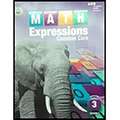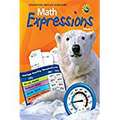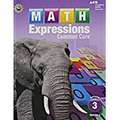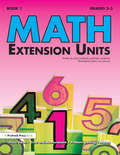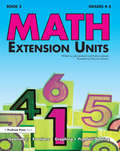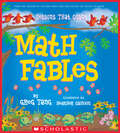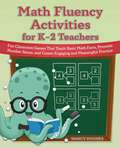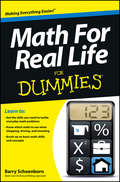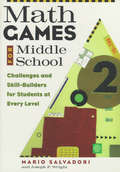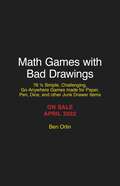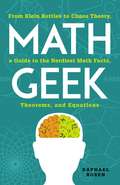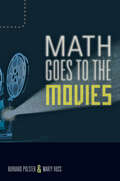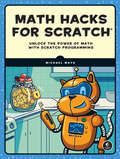- Table View
- List View
Math Expressions Common Core Volume 1 Grade 3
by Karen C. FusonMath Expressions Common Core Volume 1 Grade 3 Textbook
Math Expressions, Common Core, Grade 3, Volume 1 [Student Activity Book] (Math Expressions)
by Josh Brill Karen FusonNIMAC-sourced textbook
Math Expressions, Grade 1, Volume 1 [Student Activity Book]
by Karen C. FusonNIMAC-sourced textbook
Math Expressions, Grade 1, Volume 2 [Student Activity Book]
by Karen C. FusonNIMAC-sourced textbook
Math Expressions, Grade 3, Volume 1 [Student Activity Book]
by Karen C. FusonNIMAC-sourced textbook
Math Expressions, Grade 3, Volume 2 [Student Activity Book]
by Karen C. FusonNIMAC-sourced textbook
Math Expressions, Grade K, Volume 1 [Student Activity Book]
by Karen C. Fuson Josh BrillNIMAC-sourced textbook
Math Expressions, Grade K, Volume 2 [Student Activity Book]
by Karen C. Fuson Josh BrillNIMAC-sourced textbook
Math Expressions: Student Activity Book (Grade 4)
by Karen C. Fuson Josh BrillNIMAC-sourced textbook
Math Extension Units: Book 1, Grades 2-3
by Judy LeimbachThe purpose of this book is to help busy classroom teachers provide enrichment for those students who quickly grasp the mathematical concepts being taught and are ready to move on to more challenging units. The units include challenging activities that will require higher-level thinking and will broaden students' problem-solving skills.This book is a great resource for busy classroom teachers who need materials to extend learning opportunities for those students who quickly grasp the concepts covered in their grade level math curriculum. The book includes four units: place value, time and measurement, problem solving, and money. The units provide hours of activities that will allow students to work independently or in small groups to extend their knowledge and apply their skills. Each unit includes 13 to 14 attractive, reproducible worksheets and an assignment sheet, making this an easy way for instructors to provide challenging, enriching experiences for capable math students.For a more advanced version of math extension activities, see Math Extension Units Book 2—geometry, fractions, graphing, and problem solving.For other math units targeted toward the same goal, see Enrichment Units in Math Books 1, 2, and 3.Grades 2-3
Math Extension Units: Book 2, Grades 4-5
by Judy LeimbachThe purpose of this book is to help busy classroom teachers provide enrichment for those students who quickly grasp the mathematical concepts being taught and are ready to move on to more challenging material. The units include challenging activities that will require higher-level thinking and will broaden students' problem-solving skills.This book is a great resource for busy classroom teachers who need materials to extend learning opportunities for those students who quickly grasp the concepts covered in their grade level math curriculum. This book includes four units: geometry, fractions, graphing, and problem solving. The units provide hours of activities that will allow students to work independently or in small groups to extend their knowledge and apply their skills. Each unit includes 13 to 14 attractive, reproducible worksheets and an assignment sheet, making this an easy way for instructors to provide challenging, enriching experiences for capable math students. This can also be used for review and remediation with middle school students.For a less advanced version of math extension activities, see Math Extension Units Book 1—place value, problem solving, time and measurement, and money.For more math units geared toward the same goal, see Enrichment Activities for Math Books 1, 2, and 3.Grades 4-5
Math Fables
by Greg Tang Heather CahooonFor some children, make comes fairly easily. For others, it is a challenge nearly every step of the way. What accounts for this difference? Is there a special math gene that makes math easy for some kids and difficult for others? Fortunately, the answer is "no." Success is often determined by how fluent children are with numbers, the language of math. When kids develop a good understanding of numbers at an early age, everything else-arithmetic, algebra, even geometry-follows naturally.
Math Fables
by Greg TangFrom 1 to 10, these "lessons that count" are math magic for learning addition and subtraction.Greg Tang has built his career as an author and math missionary on the power of creative problem solving. Now, through winsome "fables" about concepts that are relevant to the very youngest math learners -- sharing, teamwork, etc. -- Greg encourages kids to see the basics of addition and subtraction in entirely new ways. Fresh, fun, and most of all, inspiring, MATH FABLES is perfect for launching young readers on the road to math success!
Math Fluency Activities for K–2 Teachers: Fun Classroom Games That Teach Basic Math Facts, Promote Number Sense, and Create Engaging and Meaningful Practice
by Nancy HughesMake learning fun and help your student master math with these parent- and teacher-friendly games and activities designed for kindergarten, first grade, and second grade.An excellent resource for teachers and parents, Math Fluency Activities for K–2 Teachers makes learning basic math facts and number sense a breeze. This book helps students in grades K–2 meet current math fluency standards for their age group. Beyond teaching speed, accuracy, and memorization, this book focuses on getting students to apply math in a variety of real-life situations. Inside you&’ll find: Current fluency standards for kindergarten, first grade, and second grade Activities, games, and ideas for teaching math to students Concrete examples and practice sections to reinforce concepts And much more! Ideal for reteaching, at-home practice, or general class time, Math Fluency Activities for K–2 Teachers is the ultimate tool for helping kids achieve math success!
Math For Real Life For Dummies
by Barry SchoenbornThe easy way to brush up on the math skills you need in real lifeNot everyone retains the math they learned in school. Like any skill, your ability to speak "math" can deteriorate if left unused. From adding and subtracting money in a bank account to figuring out the number of shingles to put on a roof, math in all of its forms factors into daily life. Math For Real Life For Dummies provides you with the simple formulas and theorems that you're likely to encounter in the workplace, the kitchen, and even when playing games.You can turn to Math For Real Life For Dummies to brush up on your math skills or to handle everyday encounters, like calculating restaurant tips, understanding interest rates, and figuring out percentages and odds. Packed with real-world examples that make sense, Math For Real Life For Dummies takes the stress out of your daily calculation encounters.Provides tips for understanding and using basic mathematical conceptsShows you how math helps the mind to reason and organize complicated situations or problems into clear, simple, and logical stepsCovers all of the math skills you're likely to need in everyday situationsIf you're looking for a practical, plain-English guide to mastering everyday math skills, Math For Real Life For Dummies has you covered.
Math Games & Activities from Around the World
by Claudia ZaslavskyMore than 70 math games, puzzles, and projects from all over the world are included in this delightful book for kids.
Math Games for Middle School: Challenges and Skill-Builders for Students at Every Level
by Mario Salvadori Joseph P. WrightFrom addition and subtraction to plane and space geometry, simultaneous linear equations, and probability, this book explains middle school math with problems that kids want to solve: "Seventy-five employees of a company buy a lotto ticket together and win $22.5 million. How much does each employee get?" Intriguing facts about the history of math show what a human creation it is, and human errors are revealed through explorations of both Maya and Hindu concepts of zero as well as Mr. William Shanks' 1858 attempt at hand-calculating pi.
Math Games with Bad Drawings: 75 1/4 Simple, Challenging, Go-Anywhere Games—And Why They Matter
by Ben OrlinBestselling author and worst-drawing artist Ben Orlin expands his oeuvre with this interactive collection of mathematical games. With 70-plus games, each taking a minute to learn and a lifetime to master, this treasure trove will delight, educate, and entertain.From beloved math popularizer Ben Orlin comes a masterfully compiled collection of dozens of playable mathematical games.This ultimate game chest draws on mathematical curios, childhood classics, and soon-to-be classics, each hand-chosen to be (1) fun, (2) thought-provoking, and (3) easy to play. With just paper, pens, and the occasional handful of coins, you and a partner can enjoy hours of fun—and hours of challenge.Orlin&’s sly humor, expansive knowledge, and so-bad-they&’re-good drawings show us how simple rules summon our best thinking.Games include: Ultimate Tic-Tac-ToeSproutsBattleshipQuantum Go FishDots and BoxesBlack HoleOrder and ChaosSequenciumPaper BoxingPropheciesArpeggiosBankerFrancoprussian LabyrinthCats and DogsAnd many more.
Math Geek
by Raphael RosenThe new "sine" of mathematical geekdom! Do you dream about long division in your sleep? Does the thought of solving abstruse equations bring a smile to your face? Do you love celebrating pi every March? Then, Math Geek was made for you! With this guide, you'll learn even more about the power of numbers as you explore their brilliant nature in ways you've never imagined. From manhole covers to bubbles to subway maps, each page gives you a glimpse of the world through renowned mathematicians' eyes and reveals how their theorems and equations can be applied to nearly everything you encounter. Covering dozens of your favorite math topics, you'll find fascinating answers to questions like: How are the waiting times for buses determined? Why is Romanesco Broccoli so mesmerizing? How do you divide a cake evenly? Should you run or walk to avoid rain showers? Filled with compelling mathematical explanations, Math Geek sheds light on the incredible world of numbers hidden deep within your day-to-day life.
Math Geek: From Klein Bottles to Chaos Theory, a Guide to the Nerdiest Math Facts, Theorems, and Equations
by Raphael RosenThe new "sine" of mathematical geekdom!Do you dream about long division in your sleep? Does the thought of solving abstruse equations bring a smile to your face? Do you love celebrating pi every March? Then, Math Geek was made for you! With this guide, you'll learn even more about the power of numbers as you explore their brilliant nature in ways you've never imagined. From manhole covers to bubbles to subway maps, each page gives you a glimpse of the world through renowned mathematicians' eyes and reveals how their theorems and equations can be applied to nearly everything you encounter. Covering dozens of your favorite math topics, you'll find fascinating answers to questions like:How are the waiting times for buses determined?Why is Romanesco Broccoli so mesmerizing?How do you divide a cake evenly?Should you run or walk to avoid rain showers? Filled with compelling mathematical explanations, Math Geek sheds light on the incredible world of numbers hidden deep within your day-to-day life.
Math Goes to the Movies
by Burkard Polster Marty RossMel Gibson teaching Euclidean geometry, Meg Ryan and Tim Robbins acting out Zeno's paradox, Michael Jackson proving in three different ways that 7 x 13 = 28. These are just a few of the intriguing mathematical snippets that occur in hundreds of movies. Burkard Polster and Marty Ross pored through the cinematic calculus to create this thorough and entertaining survey of the quirky, fun, and beautiful mathematics to be found on the big screen. Math Goes to the Movies is based on the authors' own collection of more than 700 mathematical movies and their many years using movie clips to inject moments of fun into their courses. With more than 200 illustrations, many of them screenshots from the movies themselves, this book provides an inviting way to explore math, featuring such movies as:• Good Will Hunting• A Beautiful Mind• Stand and Deliver• Pi• Die Hard• The Mirror Has Two FacesThe authors use these iconic movies to introduce and explain important and famous mathematical ideas: higher dimensions, the golden ratio, infinity, and much more. Not all math in movies makes sense, however, and Polster and Ross talk about Hollywood's most absurd blunders and outrageous mathematical scenes. Interviews with mathematical consultants to movies round out this engaging journey into the realm of cinematic mathematics.This fascinating behind-the-scenes look at movie math shows how fun and illuminating equations can be.
Math Hacks for Scratch: Unlock the Power of Math with Scratch Programming
by Michael MaysPush Scratch programming to the limits as you explore primes, Fibonacci numbers, Pascal&’s triangle, and other mathematical curiosities through hands-on coding projects.If you&’re a student looking for project ideas to practice your math and coding skills, or a Scratch enthusiast just looking for something different, this is the book for you!Discover the exciting intersection of mathematics and programming with Math Hacks for Scratch®. This book is perfect for kids, educators, and programming enthusiasts eager to learn or teach math through fun, hands-on projects using Scratch, the popular visual programming language.You&’ll see how a little bit of planning, combined with the right mathematical or coding tricks, can make complex calculations doable. These are the &“hacks&” mentioned in the title. You&’ll write programs to speed up factoring big numbers, sort out a pizza party with Pascal&’s triangle, explore Fibonacci&’s famous sequence for counting rabbits, use cryptography to create unbreakable secret codes, and so much more.Inside, you&’ll find:Step-by-Step Projects: Learn how to create interactive games, animations, and simulations that bring math concepts to life. Convert between binary and decimal to see how computers keep track of numbers. Make sense of patterns in lists, sequences, and arrays. Encode cryptograms, unscramble secret messages, and crack the Caesar cipher.Real-World Applications: See how math is used every day to calculate probabilities in games and create dynamic graphics.Expert Guidance: Benefit from the insights of author Michael Mays, a seasoned math educator with a PhD in mathematics and a 40-year teaching career.Accessible Learning: Ideal for both beginners and experienced programmers, this book offers clear explanations and practical examples that make learning fun and easy.Whether you&’re a beginning coder wanting to enhance your Scratch skills, a teacher looking to inspire students, or a parent supporting your child&’s education, Math Hacks for Scratch provides the tools to turn coding projects into math adventures.
